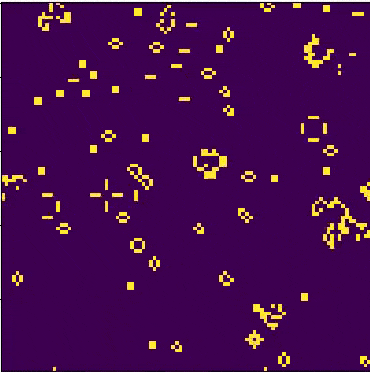康威的生命游戏是约翰·康威创造的一种细胞自动化方法。这个游戏是在考虑生物学的基础上创建的,但已经被应用于各种领域,如图形、地形生成等。。
null

“游戏”是一个零人游戏,这意味着它的进化是由它的初始状态决定的,不需要进一步的输入。一个人通过创建一个初始配置并观察其演变来与生命游戏互动,或者,对于高级“玩家”,通过创建具有特定属性的模式。 游戏如何运作 因为生命的游戏是建立在一个由九个正方形组成的网格上的,每个单元格都有八个相邻的单元格,如给定的图所示。模拟中的给定单元格(i,j)是在网格[i][j]上访问的,其中i和j分别是行和列索引。给定单元在给定时刻的值取决于其相邻单元在上一时间步的状态。康威的人生游戏有四条规则。
- 如果一个单元格处于打开状态,并且只有不到两个邻居处于打开状态,则该单元格将关闭
- 如果一个单元处于打开状态,并且有两个或三个相邻单元处于打开状态,则该单元将保持打开状态。
- 如果一个单元处于打开状态,并且有三个以上的邻居处于打开状态,则该单元将关闭。
- 如果一个单元处于关闭状态,且恰好有三个邻居处于打开状态,则该单元将打开。
![图片[2]-康威(Python的游戏实现)-yiteyi-C++库](https://www.yiteyi.com/wp-content/uploads/geeks/20201102/geeks_GameOfLifeDiagram.png)
既然我们知道它是如何工作的,接下来我们需要弄清楚如何让它工作。 方法
1. Initialize the cells in the grid.2. At each time step in the simulation, for each cell (i, j) in the grid, do the following: a. Update the value of cell (i, j) based on its neighbors, taking into account the boundary conditions. b. Update the display of grid values.
完成后,让我们着手编写代码。 要求
- 努比
- matplotlib
- argparse
- 皮加梅
现在让我们开始吧 密码
Python3
# Python code to implement Conway's Game Of Life import argparse import numpy as np import matplotlib.pyplot as plt import matplotlib.animation as animation # setting up the values for the grid ON = 255 OFF = 0 vals = [ON, OFF] def randomGrid(N): """returns a grid of NxN random values""" return np.random.choice(vals, N * N, p = [ 0.2 , 0.8 ]).reshape(N, N) def addGlider(i, j, grid): """adds a glider with top left cell at (i, j)""" glider = np.array([[ 0 , 0 , 255 ], [ 255 , 0 , 255 ], [ 0 , 255 , 255 ]]) grid[i:i + 3 , j:j + 3 ] = glider def addGosperGliderGun(i, j, grid): """adds a Gosper Glider Gun with top left cell at (i, j)""" gun = np.zeros( 11 * 38 ).reshape( 11 , 38 ) gun[ 5 ][ 1 ] = gun[ 5 ][ 2 ] = 255 gun[ 6 ][ 1 ] = gun[ 6 ][ 2 ] = 255 gun[ 3 ][ 13 ] = gun[ 3 ][ 14 ] = 255 gun[ 4 ][ 12 ] = gun[ 4 ][ 16 ] = 255 gun[ 5 ][ 11 ] = gun[ 5 ][ 17 ] = 255 gun[ 6 ][ 11 ] = gun[ 6 ][ 15 ] = gun[ 6 ][ 17 ] = gun[ 6 ][ 18 ] = 255 gun[ 7 ][ 11 ] = gun[ 7 ][ 17 ] = 255 gun[ 8 ][ 12 ] = gun[ 8 ][ 16 ] = 255 gun[ 9 ][ 13 ] = gun[ 9 ][ 14 ] = 255 gun[ 1 ][ 25 ] = 255 gun[ 2 ][ 23 ] = gun[ 2 ][ 25 ] = 255 gun[ 3 ][ 21 ] = gun[ 3 ][ 22 ] = 255 gun[ 4 ][ 21 ] = gun[ 4 ][ 22 ] = 255 gun[ 5 ][ 21 ] = gun[ 5 ][ 22 ] = 255 gun[ 6 ][ 23 ] = gun[ 6 ][ 25 ] = 255 gun[ 7 ][ 25 ] = 255 gun[ 3 ][ 35 ] = gun[ 3 ][ 36 ] = 255 gun[ 4 ][ 35 ] = gun[ 4 ][ 36 ] = 255 grid[i:i + 11 , j:j + 38 ] = gun def update(frameNum, img, grid, N): # copy grid since we require 8 neighbors # for calculation and we go line by line newGrid = grid.copy() for i in range (N): for j in range (N): # compute 8-neighbor sum # using toroidal boundary conditions - x and y wrap around # so that the simulaton takes place on a toroidal surface. total = int ((grid[i, (j - 1 ) % N] + grid[i, (j + 1 ) % N] + grid[(i - 1 ) % N, j] + grid[(i + 1 ) % N, j] + grid[(i - 1 ) % N, (j - 1 ) % N] + grid[(i - 1 ) % N, (j + 1 ) % N] + grid[(i + 1 ) % N, (j - 1 ) % N] + grid[(i + 1 ) % N, (j + 1 ) % N]) / 255 ) # apply Conway's rules if grid[i, j] = = ON: if (total < 2 ) or (total > 3 ): newGrid[i, j] = OFF else : if total = = 3 : newGrid[i, j] = ON # update data img.set_data(newGrid) grid[:] = newGrid[:] return img, # main() function def main(): # Command line args are in sys.argv[1], sys.argv[2] .. # sys.argv[0] is the script name itself and can be ignored # parse arguments parser = argparse.ArgumentParser(description = "Runs Conway's Game of Life simulation." ) # add arguments parser.add_argument( '--grid-size' , dest = 'N' , required = False ) parser.add_argument( '--mov-file' , dest = 'movfile' , required = False ) parser.add_argument( '--interval' , dest = 'interval' , required = False ) parser.add_argument( '--glider' , action = 'store_true' , required = False ) parser.add_argument( '--gosper' , action = 'store_true' , required = False ) args = parser.parse_args() # set grid size N = 100 if args.N and int (args.N) > 8 : N = int (args.N) # set animation update interval updateInterval = 50 if args.interval: updateInterval = int (args.interval) # declare grid grid = np.array([]) # check if "glider" demo flag is specified if args.glider: grid = np.zeros(N * N).reshape(N, N) addGlider( 1 , 1 , grid) elif args.gosper: grid = np.zeros(N * N).reshape(N, N) addGosperGliderGun( 10 , 10 , grid) else : # populate grid with random on/off - # more off than on grid = randomGrid(N) # set up animation fig, ax = plt.subplots() img = ax.imshow(grid, interpolation = 'nearest' ) ani = animation.FuncAnimation(fig, update, fargs = (img, grid, N, ), frames = 10 , interval = updateInterval, save_count = 50 ) # # of frames? # set output file if args.movfile: ani.save(args.movfile, fps = 30 , extra_args = [ '-vcodec' , 'libx264' ]) plt.show() # call main if __name__ = = '__main__' : main() |
不传递任何命令行参数。
现在让我们稍微放大一些,让我们看看如果add每500毫秒更新一次动画,设置尺寸32X32,并使用初始的滑翔机模式,会发生什么。
python 'filename.py' --grid-size 32 --interval 500 --glider
您可以尝试使用此代码创建不同的模拟。 参考链接:
- 本文的Github代码
- 书籍:Python游乐场:好奇程序员的极客项目
- 努比医生
- matplotlib文档
本文由 Subhajit Saha .如果你喜欢GeekSforgek,并且想投稿,你也可以邮寄你的文章进行评论-team@geeksforgeeks.org.看到你的文章出现在Geeksforgeks主页上,并帮助其他极客。 如果您发现任何不正确的地方,或者您想分享有关上述主题的更多信息,请写下评论。
© 版权声明
文章版权归作者所有,未经允许请勿转载。
THE END


![关于”PostgreSQL错误:关系[表]不存在“问题的原因和解决方案-yiteyi-C++库](https://www.yiteyi.com/wp-content/themes/zibll/img/thumbnail.svg)





